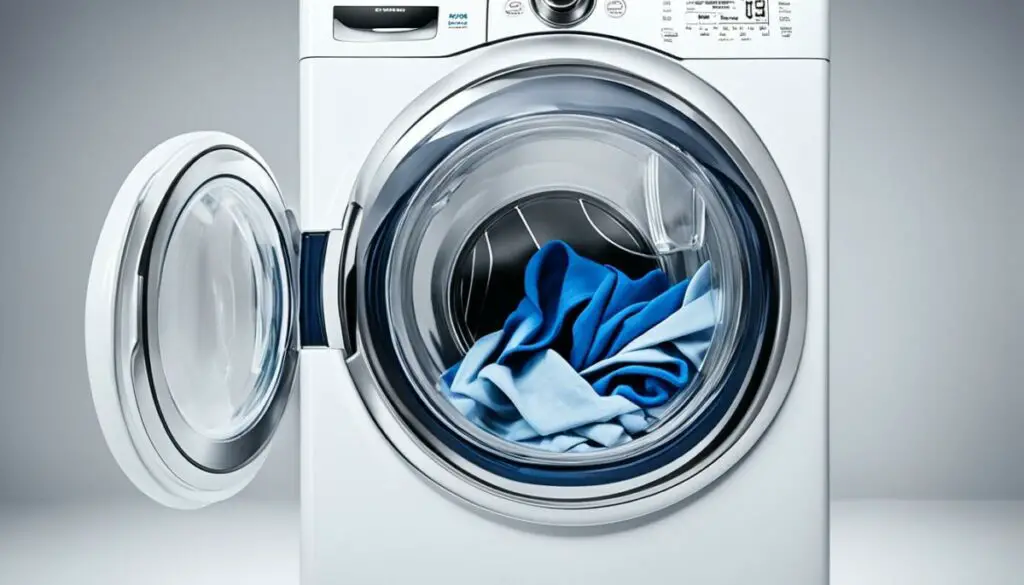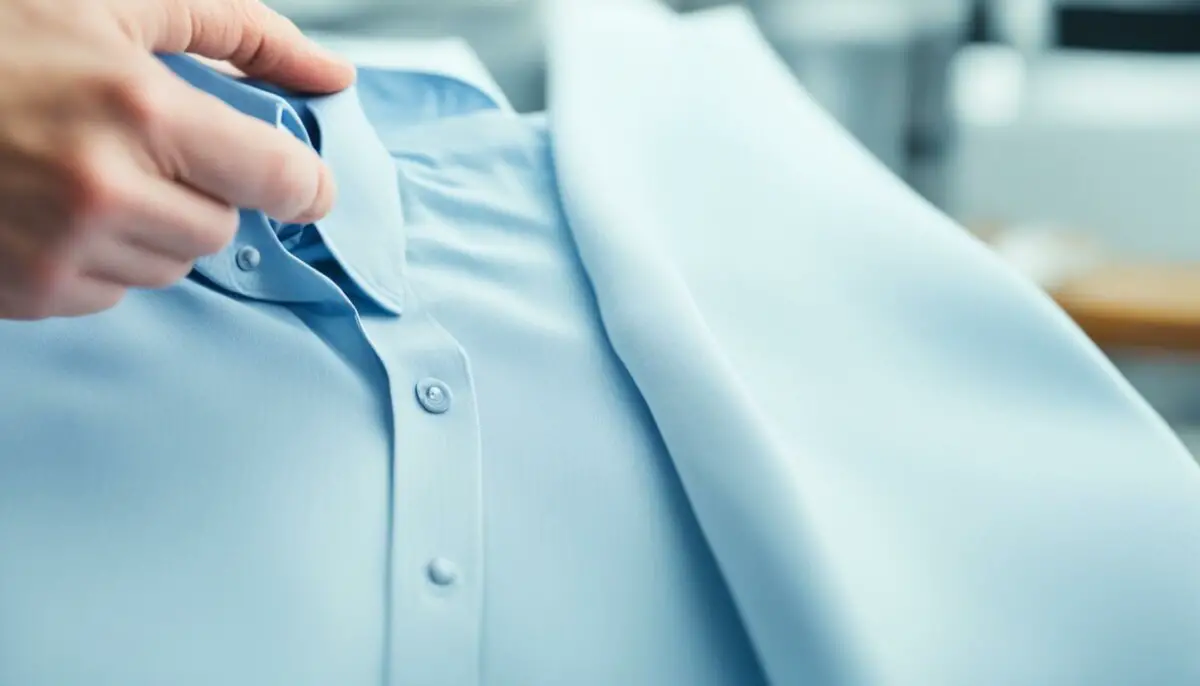Last Updated on 3 months by Francis
Have you ever heard the rumor that using steam can shrink your clothes? Well, we’re here to set the record straight. Contrary to popular belief, steam is actually a gentle and safe method for removing wrinkles and refreshing your garments. Let’s dive into the facts and debunk this common myth.
Contents
Key Takeaways:
- Steam is a gentler process than ironing and is less likely to cause shrinkage.
- Using steam relaxes the fabric fibers, making it easier to smooth out wrinkles and creases.
- Steaming does not involve direct contact with the fabric, reducing the risk of shrinkage.
- While there are rare cases where steaming can indirectly lead to shrinkage, it is generally a safe and effective method for freshening up clothes.
- By following the care labels on your clothes and using steam appropriately, you can confidently maintain your garments without worrying about shrinkage.
Understanding the Process of Steaming

Steaming clothes is a popular method for removing wrinkles and freshening up garments. Unlike ironing, which involves direct contact with the fabric, steaming is a gentler process that relaxes the fibers in the cloth. This relaxation makes it easier to smooth out wrinkles and creases, leaving your clothes looking neat and wrinkle-free.
When steaming clothes, hot steam is used to permeate the fabric, effectively releasing the wrinkles. The steamers available in the market come in different types and sizes, but they all operate on the same principle. They generate steam by heating water and then direct the steam onto the fabric.
One of the benefits of steaming clothes is that it can be used on delicate or sensitive materials. Since there is no direct contact, steaming is less likely to damage fabrics compared to ironing. This makes it an ideal method for steaming garments made of silk, lace, or other delicate materials.
Additionally, steaming clothes has the added advantage of refreshing your garments between washes. The hot steam kills bacteria and eliminates odors, leaving your clothes smelling fresh and clean. It is a convenient way to revitalize your wardrobe without going through the hassle of washing every item.
- Removal of wrinkles and creases
- Gentle and safe for delicate fabrics
- Elimination of bacteria and odors
- Refreshes clothes without washing
In summary, steaming clothes is an effective and gentle method for removing wrinkles and freshening up garments. It is suitable for a wide range of fabrics and offers additional benefits such as killing bacteria and eliminating odors. With the right steamer and technique, you can easily maintain a wrinkle-free and freshly scented wardrobe.
Debunking the Myth of Shrinkage

The belief that steaming can cause clothes to shrink is a myth. In reality, the steam’s gentle and indirect contact with the fabric relaxes the fibers, reducing the risk of shrinkage. While there are cases where steaming can indirectly lead to shrinkage, it is usually due to pre-existing issues with the fabric, not the steaming process itself. It is important to read the care labels on clothes and follow the manufacturer’s instructions to avoid any potential damage or shrinkage.
When steaming clothes, the steam works by loosening the fibers and removing wrinkles without the direct heat and pressure of an iron. The steam relaxes and reconditions the fabric, allowing it to regain its natural shape and size. This gentle process is particularly beneficial for delicate fabrics that can be easily damaged by direct heat or pressure.
Debunking the Myth with Expert Opinions
“The idea that steam can shrink clothes is simply not true. It’s a common misconception among many individuals. Steam is actually a great alternative to ironing as it provides a more gentle approach to removing wrinkles and freshening up garments.” – Sarah Johnson, Fashion Designer
Experts agree that the myth of clothes shrinking with steam is not based on scientific evidence or experience. The misconception may stem from cases where the fabric itself is prone to shrinkage due to its type, quality, or construction. In such instances, the shrinkage would occur regardless of the steaming method used.
By following the care instructions on clothing labels and using steaming techniques correctly, you can confidently enjoy the benefits of steaming without worrying about shrinkage. Keep in mind that steaming is suitable for a variety of fabrics, including cotton, silk, linen, and polyester. However, it’s always a good idea to test a small, inconspicuous area of the fabric before steaming the entire garment, especially if you are unsure of the fabric’s reaction to steam.
| Myth | Fact |
|---|---|
| Steam can shrink clothes | The belief that steam can shrink clothes is a myth. Steam’s gentle and indirect contact with fabric relaxes the fibers, reducing the risk of shrinkage. |
| Steaming always causes shrinkage | While there are cases where steaming can indirectly lead to shrinkage, it is usually due to pre-existing issues with the fabric, not the steaming process itself. |
| All fabrics react the same way to steam | Different fabrics may have varying reactions to steam. It is important to read the care labels on clothes and follow the manufacturer’s instructions to avoid any potential damage or shrinkage. |
By understanding the facts and debunking the myth of steam shrinking clothes, you can confidently use steam to freshen up and remove wrinkles from your garments without worrying about unintentional damage or shrinkage.
Tips for Steaming Clothes Without Shrinking Them

To steam clothes without causing shrinkage, it is important to follow some practical tips. By taking these precautions, you can ensure that your favorite garments remain in excellent condition.
Check the care label: Before steaming any garment, carefully read the care label to ensure that it is suitable for steaming. Some fabrics may be more delicate or sensitive to heat, so it’s important to be aware of any specific recommendations or warnings.
Test a small area first: If you are unsure about steaming a particular fabric, it is a good idea to test a small, inconspicuous area first. This will help you determine if the fabric reacts negatively to steam, ensuring that you won’t accidentally damage the entire garment.
Use the right temperature and steam settings: Different fabrics require different levels of heat and steam. It’s essential to adjust the temperature and steam settings on your steamer according to the fabric type. For example, delicate fabrics like silk may require lower heat and a gentler steam flow, while thicker fabrics like cotton may benefit from higher heat and stronger steam.
Avoid oversteaming: While steaming is a safe method for removing wrinkles, it is important to avoid oversteaming. Excessive heat and prolonged exposure to steam can weaken the fabric fibers, potentially leading to shrinkage or damage. Be mindful of the steaming duration, and if needed, take breaks between steaming sessions to allow the fabric to cool down.
Use a protective cloth for delicate fabrics: If you are steaming a delicate fabric like lace or chiffon, consider using a protective cloth. This extra layer of fabric will help prevent direct contact between the steamer and the delicate fabric, reducing the risk of shrinkage or damage.
Air dry after steaming: After steaming, allow your clothes to air dry naturally. This will help the fabric regain its original shape and prevent any moisture-related issues, such as mildew or shrinking. Avoid using a dryer or exposing the steamed clothes to direct heat.
Remember, steaming is a gentle and effective method for removing wrinkles and freshening up your clothes. By carefully following these tips, you can confidently steam your garments without worrying about shrinkage or damage.
The Impact of Dryers on Shrinkage
While steam has been established as a safe method for preventing shrinkage, the same cannot be said for dryers. The tumbling action and heat in dryers can cause garments to shrink, especially if they are already stretched or pulled out of shape. Manufacturers often stretch fabric when making garments, and the warmth of the water during washing causes the fibers to revert to their natural state, resulting in shrinkage. However, drying clothes with heat can also have the opposite effect, stretching the fibers slightly as they lose moisture. It is important to follow the manufacturer’s instructions and to avoid over-drying, as it can damage fabrics made of natural fibers like cotton, linen, and wool.
The Truth About Spin Speeds in Washing Machines

Spin speed plays a crucial role in the performance of washing machines. It refers to the number of revolutions per minute (rpm) that the drum spins during the spin cycle. Understanding the impact of spin speed on clothes is essential to ensure optimal washing results and garment longevity.
When it comes to spin speed, higher doesn’t always mean better. While higher spin speeds can extract more water from the laundry, resulting in shorter drying times, they may not be suitable for all types of fabrics. Robust fabrics like cotton can withstand higher spin speeds, but delicate fabrics like silk and lace require lower spin speeds to prevent damage or shrinkage.
Choosing the right spin speed is crucial to maintain the quality of your clothes. Here are some guidelines:
- For sturdy fabrics like cotton or denim, opt for higher spin speeds (1200-1400 rpm) to facilitate better water extraction. This will reduce drying time and result in fresh, clean laundry.
- For delicate fabrics such as silk, lace, or wool, choose lower spin speeds (600-800 rpm) to protect the fibers and prevent stretching or shrinkage.
It’s important to note that modern washing machines are designed with innovative technology to minimize noise levels, even at higher spin speeds. This ensures a quieter laundry experience without compromising performance.
Here’s a visual representation of the impact of spin speed on different fabric types:
| Fabric Type | Recommended Spin Speed (rpm) |
|---|---|
| Cotton | 1200-1400 |
| Denim | 1200-1400 |
| Linen | 1000-1200 |
| Silk | 600-800 |
| Lace | 600-800 |
| Wool | 600-800 |
Remember, selecting the appropriate spin speed for your laundry will help preserve the quality and lifespan of your clothes. So, take a moment to check the care labels and make an informed decision when choosing the spin speed for each wash cycle.
Myths and Facts About Spin Speeds
When it comes to spin speeds in washing machines, there are various myths and misconceptions that can leave you scratching your head. In this section, we’ll debunk these spin speed myths and shed light on the truth behind them.
Myth 1: Higher Spin Speeds Will Ruin Clothes
Contrary to popular belief, higher spin speeds won’t necessarily ruin your clothes. The key lies in using the appropriate settings for each fabric type. While it’s true that faster spins generate more centrifugal force, leading to increased stress on the fabric, modern washing machines are designed to accommodate higher spin speeds without causing damage. By selecting the right settings based on the fabric’s requirements, you can enjoy the benefits of fast-spinning drums without worry.
Myth 2: Machines with Higher Spin Speeds Are Prone to Breakdowns
This myth couldn’t be further from the truth. Washing machine manufacturers have invested significantly in designing reliable appliances that can withstand higher spin speeds. Today’s machines are equipped with advanced features and sturdy construction to ensure durability and minimize breakdowns. Don’t let the fear of a higher spin speed deter you from opting for a washing machine that meets all your laundry needs.
Myth 3: Higher Spin Speeds Are Always Better
While it’s tempting to assume that higher spin speeds are always superior, it’s important to consider the type of fabrics you’re washing. Delicate fabrics like silk and lace are more susceptible to damage at higher spin speeds. The increased agitation can cause stretching, distortion, or even shrinkage in some cases. On the other hand, sturdier fabrics like cotton can handle higher spin speeds without any adverse effects. It’s essential to understand the specific requirements of each fabric and adjust your spin speed accordingly.
Myth 4: A Loud Washing Machine Equals a High Spin Speed
This myth links the noise level of a washing machine to its spin speed. However, a loud machine does not necessarily indicate a high spin speed. Loud noises during the wash cycle can be caused by an unbalanced load, loose components, or even the type of machine itself. It’s best to consult your machine’s manual or reach out to the manufacturer if you’re concerned about excessive noise levels. Don’t let noise mislead you when it comes to determining the spin speed of your washing machine.
By debunking these spin speed myths, we hope to provide you with a clearer understanding of how to leverage spin speeds effectively for optimal laundry results. Remember, selecting the appropriate spin speed based on fabric type and following manufacturer guidelines will help you achieve excellent cleaning performance while safeguarding your garments from damage or shrinkage.
Understanding the Impact of Spin Speed on Fabrics
The spin speed of your washing machine plays a crucial role in the care of your fabrics. It can have a significant impact on both the effectiveness of cleaning and the potential for damage, including shrinkage. Choosing the right spin speed for different types of fabrics is essential to ensure the longevity and preservation of your clothing.
When it comes to spin speed, there is a general rule of thumb to follow. Higher spin speeds are suitable for robust fabrics like cotton, as they effectively extract more water, resulting in shorter drying times. On the other hand, lower spin speeds are more appropriate for delicate fabrics such as silks and lace, reducing the risk of damage and shrinkage.
It is important to consider the specific fabric being washed and consult the care labels for any special instructions. Here are some guidelines to help you choose the right spin speed:
- Cotton: For durable fabrics like cotton, a higher spin speed, usually around 1000-1200 rpm, is suitable. This helps to efficiently remove excess water, reducing drying time.
- Synthetic fabrics: Fabrics like polyester and nylon can be washed at a slightly lower spin speed, around 800-1000 rpm, to prevent potential damage to the fibers.
- Delicate fabrics: Delicate fabrics such as silk and lace require extra care. Opt for a gentle spin cycle with a lower speed, typically around 600-800 rpm, to minimize the risk of damage or distortion.
It’s worth noting that modern washing machines are designed with innovative technology to minimize noise levels and vibration, even at higher spin speeds. This ensures a quieter and more convenient laundry experience.
By taking the time to choose the appropriate spin speed for your fabrics, you can effectively clean your clothes without causing unnecessary damage or shrinkage. Remember to always read and follow the care labels on your garments to maintain their quality and longevity.
Having a visual representation of the impact of spin speed on fabrics can provide a clearer understanding. The table below summarizes the recommended spin speeds for different fabric types:
| Fabric Type | Recommended Spin Speed (rpm) |
|---|---|
| Cotton | 1000-1200 |
| Synthetic Fabrics | 800-1000 |
| Delicate Fabrics | 600-800 |
Conclusion
In conclusion, the belief that steam can shrink clothes is a myth. Steaming is actually a safe and effective method for removing wrinkles and freshening up clothes without causing damage or shrinkage. While there may be cases where steaming indirectly leads to shrinkage, it is generally due to pre-existing issues with the fabric rather than the steaming process itself.
By following the tips provided throughout this article and choosing the appropriate settings for steaming and spin speeds in washing machines, you can confidently maintain your clothes without worrying about shrinkage. It is important to check the care labels on your garments, test a small area if unsure, use the correct temperature and steam settings for different fabrics, and avoid oversteaming. Employing these practices will help ensure that your clothes remain in excellent condition.
Remember, steam is a gentle method that relaxes the fibers in the fabric, making it easier to smooth out wrinkles and creases. It does not involve direct contact like ironing, minimizing the risk of shrinkage. So go ahead and enjoy the benefits of steaming your clothes – they will be fresh, wrinkle-free, and ready to wear!
FAQ
Does steam shrink clothes?
No, steam does not shrink clothes. In fact, it is a gentler process than ironing and is less likely to cause shrinkage. Steam works by relaxing the fibers in the fabric, making it easier to smooth out wrinkles and creases. The indirect contact with the fabric reduces the risk of shrinkage. However, it is important to follow the care label instructions on the fabric to avoid any potential damage or shrinkage.
Can I shrink clothes with steam?
No, you cannot shrink clothes with steam. Steam is primarily used to remove wrinkles and freshen up clothes. It relaxes the fibers in the fabric, making it easy to smooth out wrinkles and creases. While there are cases where steaming can indirectly lead to shrinkage, it is usually due to pre-existing issues with the fabric, not the steaming process itself. It is important to read the care labels and follow the manufacturer’s instructions to avoid any potential damage or shrinkage.
How does steaming work on clothes?
Steaming involves using hot steam to relax the fibers in the fabric, making it easier to smooth out wrinkles and creases. Unlike ironing, which requires direct contact with the fabric, steaming is gentler on fabrics and can be used on delicate or sensitive materials. Steamers come in a variety of types and sizes, using water to generate steam that is then directed onto the fabric. Steaming also helps to freshen up clothes between washings by killing bacteria and eliminating odors.
How can I steam clothes without causing shrinkage?
To steam clothes without causing shrinkage, it is important to follow some practical tips. These include checking the care label of the fabric to ensure it is suitable for steaming, testing a small area first if unsure, using the right temperature and steam settings for different fabrics, avoiding oversteaming, using a protective cloth for delicate fabrics, and allowing the fabric to air dry after steaming. By following these tips, you can safely steam your clothes without worrying about shrinkage.
Do dryers shrink clothes?
Yes, dryers can shrink clothes. The tumbling action and heat in dryers can cause garments to shrink, especially if they are already stretched or pulled out of shape. It is important to follow the manufacturer’s instructions and avoid over-drying, as it can damage fabrics made of natural fibers like cotton, linen, and wool.
What is spin speed in washing machines?
Spin speed in washing machines refers to the number of revolutions per minute (rpm) that the drum spins during the spin cycle. Higher spin speeds extract more water from the laundry, resulting in shorter drying times. It is important to choose the right spin speed based on the fabric being washed to avoid damage or shrinkage.
Are higher spin speeds better for all fabrics?
No, higher spin speeds are not always better for all fabrics. Higher spin speeds are suitable for robust fabrics like cotton, while lower spin speeds are more appropriate for delicate fabrics like silk and lace. It is important to consider the specific fabric being washed and consult the care labels for any special instructions to avoid damage or shrinkage.
Are there any myths about spin speeds in washing machines?
Yes, there are several myths surrounding spin speeds in washing machines. Some common myths include that higher spin speeds will ruin clothes or cause breakdowns in machines. However, modern washing machines are designed to be reliable and have innovative features to ensure durability. It is also a myth that all fabrics should be washed at higher spin speeds. Delicate fabrics are more likely to be damaged at higher spin speeds, and a high spin speed can also lead to shrinkage in some cases. Additionally, a loud washing machine does not necessarily indicate a high spin speed, as it may be due to an unbalanced load.
How does spin speed impact fabrics in washing machines?
The impact of spin speed on fabrics can vary depending on the type of fabric and its condition. In general, higher spin speeds are suitable for robust fabrics like cotton, while lower spin speeds are better for delicate fabrics like silks and lace. It is important to consider the specific fabric being washed and consult the care labels for any special instructions. By choosing the right spin speed, you can ensure that your clothes are cleaned effectively without causing damage or shrinkage.
Source Links
- https://homelyitems.com/does-steaming-shrink-clothes/
- https://www.appliancecity.co.uk/news/appliances-explained/myth-buster-washing-machines-high-spin-speeds/
- https://www.washingtonpost.com/archive/realestate/2004/11/06/heat-didnt-shrink-that-shirt-fabric-expert-offers-the-scoop/ededa88a-68ec-4405-9ce7-686d63fcb0a1/








